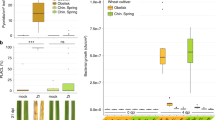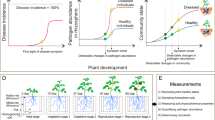Abstract
Interactions between plants and compatible fungal pathogens are spatially and temporally dynamic, posing a major challenge for sampling and data analysis. A protocol is described for the infection of the model grass species Brachypodium distachyon with Magnaporthe grisea (rice blast), together with modifications to extend the use to rice and barley. We outline a method for the preparation of long-term stocks of virulent fungal pathogens and for the generation of fungal inoculants for challenge of host plants. Host plant growth, pathogen inoculation and plant sampling protocols are presented together with methods for assessing the efficiency of both infection and sampling procedures. Included in the anticipated results is a description of the use of metabolite fingerprinting and multivariate data analysis to assess disease synchrony and validate system reproducibility between experiments. The design concepts will have value in any studies using biological systems that contain dynamic variance associated with large compositional changes in sample matrix over time.
This is a preview of subscription content, access via your institution
Access options
Subscribe to this journal
Receive 12 print issues and online access
$259.00 per year
only $21.58 per issue
Buy this article
- Purchase on Springer Link
- Instant access to full article PDF
Prices may be subject to local taxes which are calculated during checkout









Similar content being viewed by others
References
Xu, J.R. et al. The dawn of fungal pathogen genomics. Annu. Rev. Phytopathol. 44, 337–366 (2006).
Talbot, N.J. On the trail of a cereal killer: exploring the biology of Magnaporthe grisea. Annu. Rev. Micro. 57, 177–202 (2003).
Goswani, R.S. & Kistler, H.C. Heading for disaster: Fusarium graminearum on cereal crops. Mol. Plant. Pathol. 5, 515–525 (2004).
Basse, C.W. & Steinberg, G. Ustilago maydis, model system for analysis of the molecular basis of fungal pathogenicity. Mol. Plant Pathol. 5, 83–92 (2004).
Howard, R.J. & Valent, B. Breaking and entering: host penetration by the fungal rice blast pathogen Magnaporthe grisea. Annu. Rev. Microbiol. 50, 491–512 (1996).
Chisholm, S.T. et al. Host-microbe interactions: shaping the evolution of the plant immune response. Cell 124, 803–814 (2006).
Martin, G.B. et al. Understanding the functions of plant disease resistance proteins. Annu. Rev. Plant Biol. 54, 23–61 (2003).
Greenberg, J.T. & Yao, N. The role and regulation of programmed cell death in plant-pathogen interactions. Cell Microbiol. 6, 201–211 (2004).
Scholes, J., Lee, P., Horton, P. & Lewis, D. Invertase: understanding changes in the photosynthetic and carbohydrate metabolism of barley leaves infected with powdery mildew. New Phytol. 126, 213–222 (1994).
Swarbrick, P., Schulze-Lefert, P. & Scholes, J. Metabolic consequences of susceptibility and resistance (race-specific and broad spectrum) in barley leaves challenged with powdery mildew. Plant Cell. Environ. 29, 1061–1076 (2006).
Nomura, K. et al. Suppression of host defence in compatible plant-Pseudomonas syringae interactions. Curr. Opin. Plant Biol. 8, 361–368 (2005).
Solomon, P.S., Tan, K-C. & Oliver, R.P. The nutrient supply of pathogenic fungi; a fertile field for study. Mol. Plant Patholol. 4, 203–210 (2003).
Kamoun, S. A catalogue of the effector secretome of plant pathogenic oomycetes. Ann. Rev. Phytopathol. 44, 41–60 (2006).
Draper, J. et al. Brachypodium distachyon. A new model system for functional genomics in grasses. Plant Physiol. 127, 1539–1555 (2001).
Cousin, A. et al. The MAP kinase-encoding gene MgFus3 of the non-appressorium phytopathogen Mycosphaerella graminicola is required for penetration and in vitro pycnidia formation. Mol. Plant Pathol. 7, 269–278 (2006).
Slawecki, R.A. et al. Novel fungitoxicity assays for inhibition of germination-associated adhesion of Botrytis cinerea and Puccinia recondita spores. Appl. Envirol. Microbiol. 68, 597–601 (2002).
Schurch, S. et al. Molecular population genetic analysis differentiates two virulence mechanisms of the fungal avirulence gene NIP1. Mol. Plant Microbe Interact. 17, 1114–1125 (2004).
Jones, M.J. & Dunkle, L.D. Factors regulating the synthesis of a cyclic peptide pathotoxin produced by Cochliobolus carbonum. Mycol. Res. 102, 1381–1386 (1998).
Dean, R.A. et al. The genome sequence of the rice blast fungus Magnaporthe grisea. Nature 434, 980–986 (2005).
Sesma, A. & Osbourn, A.E. The rice leaf blast pathogen undergoes developmental processes typical of root-infecting fungi. Nature 431, 582–586 (2004).
Ou, S.H. Rice diseases. Commonwealth Mycological Institute Kew Surrey (1987).
Routledge, A. et al. Magnaporthe grisea interactions with the model grass Brachypodium distachyon closely resemble those with rice (Oryza sativa). Mol. Plant Pathol. 5, 253–265 (2004).
Talbot, N.J., Saich, Y.P., Ma, M. & Hamer, J.E. Karyotypic variation within clonal lineages of the rice blast fungus, Magnaporthe grisea. Appl. Environ. Microbiol. 59, 585–593 (1993).
Soanes, D.M. et al. Regulation of the MPG1 hydrophobin gene in the rice blast fungus Magnaporthe grisea. Mol. Plant Microbe Interact. 15, 1253–1267 (2002).
Giles, P.F. et al. A relational database for the discovery of genes encoding amino acid biosynthetic enzymes in pathogenic fungi. Comp. Funct. Genom. 4, 4–15 (2003).
Hamer, J.E. et al. A mechanism for surface attachment in spores of a plant pathogenic fungus. Science 239, 288–290 (1988).
Valent, B. & Chumley, F.G. Molecular genetic-analysis of the rice blast fungus, Magnaporthe grisea. Annu. Rev. Phytopathol. 29, 443–467 (1991).
Veneault-Fourrey, C. et al. Fungal cell death is necessary for infection by the rice blast fungus. Science 312, 580–583 (2006).
Kankanala, P., Czymmek, K. & Valent, B. Roles for rice membrane dynamics and plasmodesmata during biotrophic invasion by the blast fungus. Plant Cell 19, 706–724 (2007).
Talbot, N. Having a blast: exploring the pathogenicity of Magnaporthe grisea. Trends Microbiol. 3, 9–16 (1995).
Perfect, S.E. & Green, J.R. Infection structures of biotrophic and hemibiotrophic fungal plant pathogens. Mol. Plant Pathol. 2, 101–108 (2001).
Hood, M.E. & Shew, H.D. Application of KOH-analine blue fluorescence in the study of plant-fungal interactions. Phytopathol. 86, 704–708 (1996).
Beckmann, M., Parker, D., Enot, D.P., Duval, E. & Draper, J. High-throughput, nontargeted metabolite fingerprinting using nominal mass flow injection electrospray mass spectrometry. Nat. Protoc. 3, 486–504 (2008).
Enot, D.P. et al. Preprocessing, classification modeling and feature selection using flow injection electrospray mass spectrometry metabolite fingerprint data. Nat. Protoc. 3, 446–470 (2008).
Acknowledgements
We thank all collaborators who provided valuable samples to develop this protocol and in particular Rob Darby for maintaining laboratory infrastructure, equipment and materials. Metabolite analysis, statistical work and biological materials used in example data were generated as part of the UK Biotechnology and Biological Sciences Research Council grants BB/D006953/1 (D.P. and J.D.), BB/D006791/1 (N.T. and Z.C.R.).
Author information
Authors and Affiliations
Corresponding author
Rights and permissions
About this article
Cite this article
Parker, D., Beckmann, M., Enot, D. et al. Rice blast infection of Brachypodium distachyon as a model system to study dynamic host/pathogen interactions. Nat Protoc 3, 435–445 (2008). https://doi.org/10.1038/nprot.2007.499
Published:
Issue Date:
DOI: https://doi.org/10.1038/nprot.2007.499
This article is cited by
-
The cell cycle, autophagy, and cell wall integrity pathway jointly governed by MoSwe1 in Magnaporthe oryzae
Cell Communication and Signaling (2024)
-
Improving blast resistance of maintainer line DRR 9B by transferring broad spectrum resistance gene Pi2 by marker assisted selection in rice
Physiology and Molecular Biology of Plants (2023)
-
Improving rice blast resistance of Feng39S through molecular marker-assisted backcrossing
Rice (2019)
-
Developing japonica rice introgression lines with multiple resistance genes for brown planthopper, bacterial blight, rice blast, and rice stripe virus using molecular breeding
Molecular Genetics and Genomics (2018)
-
Expression profiling of marker genes responsive to the defence-associated phytohormones salicylic acid, jasmonic acid and ethylene in Brachypodium distachyon
BMC Plant Biology (2016)
Comments
By submitting a comment you agree to abide by our Terms and Community Guidelines. If you find something abusive or that does not comply with our terms or guidelines please flag it as inappropriate.



